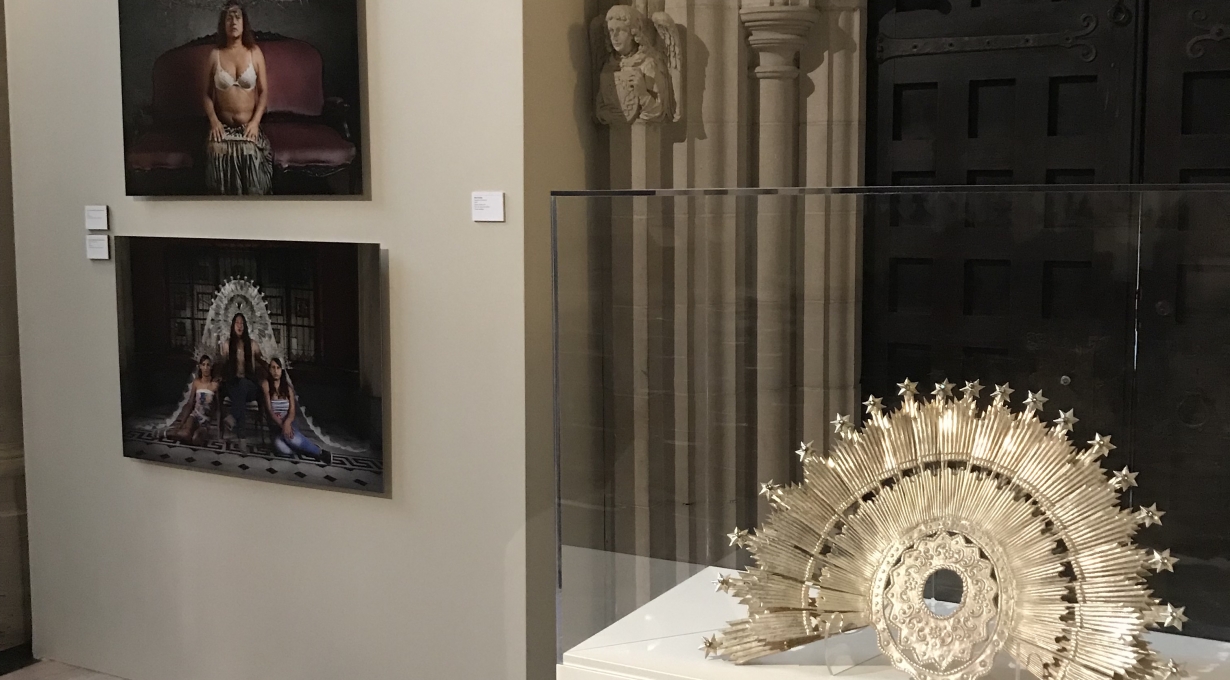Meet the Artists: Andrew Mroczek and Juan Jose Barboza-Gubo

Works from Andrew Mroczek and Juan Jose Barboza-Gubo's series Virgenes de la Puerta (Virgin of the Door) appear in the Value of Sanctuary: Building a House Without Walls, now on view in the Cathedral. You can find Andrew on instagram @andrewmroczek.
What were you thinking about when creating this piece of work? Had you spent any time considering the word “sanctuary”?
The process of creating the Virgenes de la Puerta series began with in-depth conversations with several transgender women in Peru. Aside from the violence and oppression they each experienced, the subject of safe spaces and places of faith were a part of nearly every conversation. Though not all of the women we’ve collaborated with have experienced rejection from their families because of their gender identity, nearly all were rejected by their churches. Faith has a large role in the daily lives of most Peruvians, so this type of rejection not only destroys their sense of community, it virtually cripples their existence by a forced isolation.
In this series, we honor the diversity of the Peruvian culture by re-incorporating these women into the cultural landscape and history of Peru. We celebrate them by presenting them as relevant iconic figures within the context of their native land. The images are influenced by 19th-Century Colonial painting, and they incorporate cultural and religious iconography in an effort to pay homage to the resilience and beauty of these women to strengthen, empower, and embed a sense of pride within the current and future generations of Peru’s LGBTQ community.
The title of the series comes from the widely known story of the Virgen de la Puerta (Virgin of the Door), which dates back to the mid-seventeenth century in Otuzco, Peru. There is also a lesser-known secondary version, which is set sometime in the late 1970s to early 1980s, and was told word-of-mouth within the communities of transgender women who had come together to form their own congregation – a new sanctuary where they can live their true identities and practice their faith openly and without fear or judgment. While it’s impossible to confirm the validity of the secondary version, the story is still told, as both fact and fiction, and in many ways acts as an anthem for many transgender women of Peru.
What does it mean to you and/or the piece of art to be shown in a place of worship?
The Sanctuary exhibition has provided our work with a site and an audience that we didn’t imagine possible for this series. What might not be apparent is just how special this is for the women we’ve worked with, who are generally not able to enter into spaces like these in the more urban areas of Peru. The majority of the women in the series were living in Lima at the time we collaborated with them. Unfortunately, there are members of the clergy who are very vocal in their ridicule of LGBTQ-identifying people within their sermons, their writings, and even on television and radio interviews. This creates a toxic environment for gay and trans Peruvians – it makes it permissible to for people to hate, chastise, and discriminate again gender and sexual minorities.
For the Cathedral of St. John the Divine to allow this work to be displayed within its walls sends a message of inclusivity to the women we’ve photographed. We like to think it also provides them some hope.
It’s also meaningful to have the large crown on display, as well. In Peru we worked closely with local artisans in the design and production of objects used in the images, including silver and gold crowns, a 25-foot hand-crocheted veil, and the Tapada’s gown, which is comprised of hundreds of embroidered flowers made by women in Ayacucho, a city known for its exquisite embroidery and needlework. We wanted the women to be surrounded by everything that makes Peru so unique and beautiful. The crown on display at the Cathedral was used in our portrait of Maricielo, a trans activist in Lima. It is made entirely by hand of sterling silver-plated bronze. It is also the first crown we made under the supervision of an artisan that creates similar pieces for the churches of Peru. The portrait of Maricielo with this crown has become the iconic image for the series.
What were your first impressions of the Cathedral?
It goes without saying that the Cathedral is truly majestic! And even at its grand scale, it was both mesmerizing and unexpected just how warm and intimate the spaces are.
What artists or artworks are you inspired by?
The roster of artists in the Sanctuary exhibition read like a list of artists we’ve loved and followed for years… Cassils, Kiki Smith, Latoya Ruby-Frazier, Jenny Holzer, Louise Bourgeois…. Just to name a few. Our work in Peru has provided us the opportunity to experience both art and culture in ways that were inspiring – while many people might consider the artisans we’ve worked with “craftspeople,” we found many of them to be passionate artists and storytellers in every sense.